Poland
![]()
This article is about the republic. For other meanings, see Poland (disambiguation).
Template:Infobox State/Maintenance/NAME-German
Poland (Polish Polska [ˈpɔlska] ![]() , officially Republic of Poland, Polish Rzeczpospolita Polska,
, officially Republic of Poland, Polish Rzeczpospolita Polska, ![]() ) is a parliamentary republic in Central Europe. The capital and also the largest city of the country is Warsaw (Polish: Warszawa), the largest metropolitan area is the metropolitan region around Katowice (Katowice). Other cities with more than 400,000 inhabitants are Kraków, Łódź, Wrocław, Poznań, Gdańsk and Szczecin. Poland is a unitary state divided into 16 voivodeships. With a size of 312,696 square kilometers, Poland is the sixth largest country in the European Union and the fifth most populous with 38.5 million inhabitants. The predominant climate is oceanic in the north and west, and continental in the south and east of the country.
) is a parliamentary republic in Central Europe. The capital and also the largest city of the country is Warsaw (Polish: Warszawa), the largest metropolitan area is the metropolitan region around Katowice (Katowice). Other cities with more than 400,000 inhabitants are Kraków, Łódź, Wrocław, Poznań, Gdańsk and Szczecin. Poland is a unitary state divided into 16 voivodeships. With a size of 312,696 square kilometers, Poland is the sixth largest country in the European Union and the fifth most populous with 38.5 million inhabitants. The predominant climate is oceanic in the north and west, and continental in the south and east of the country.
In the early Middle Ages, in the course of the migration of peoples, tribes of the Western Poles settled in parts of the present-day territory of the state. The first documented mention of Poland was in 966 under the first historically attested Polish Duke Mieszko I, who opened the country to Christianity. In 1025, the Kingdom of Poland was founded until 1569, when the Union of Lublin united it with the Grand Duchy of Lithuania to form the Royal Republic of Poland-Lithuania, becoming one of the largest and most influential states in Europe. During this period, the first modern constitution in Europe was created in 1791.
Deprived of its sovereignty by the neighboring states through the three partitions of Poland at the end of the 18th century, Poland regained its independence in 1918 with the Treaty of Versailles. The invasion of the German Empire and the Soviet Union at the beginning of World War II and their rule of occupation cost the lives of millions of Polish citizens, especially Polish Jews. After the war, Poland received new borders as part of Poland's westward shift. Under Soviet influence since 1952 as the People's Republic of Poland, the country underwent a political and economic system change in 1989, especially as a result of the influence of the Solidarność movement. Poland has been a member of the European Union since 2004 and is a strong economic force in Central Europe.
In terms of gross domestic product, Poland is the 22nd largest economy in the world. The United Nations Development Program ranks Poland among the countries with very high human development. Situated between Western and Eastern European cultural areas and shaped by an eventful history, the country developed a rich cultural heritage. Some of its citizens made important contributions in the natural and social sciences, mathematics, literature, film and music. Poland is a member of the United Nations, the OSCE, NATO, the Council of Europe and the European Union.
Country name
The Polish name of the Republic of Poland is "Rzeczpospolita Polska", whereby the designation Rzeczpospolita explicitly refers to the Polish aristocratic republic (until 1795) and is not a mere translation of Republic. In contrast to the German translation from Latin: Sache des Volkes oder öffentliche Sache, the Polish Rzeczpospolita literally means: common cause or matter of the general public. The term Rzeczpospolita is reserved for the Republic of Poland alone; other republics are referred to in Polish simply as Republika.
The name Poland derives from the West Slavic tribe of the Polans (Polanie), who settled in the 5th century on the territory of today's Wielkopolska Voivodeship around Poznań and Gniezno, between the rivers Oder (Odra) and Vistula (Wisła). The Polans, who were called that only around the year 1000, were mostly arable farmers; their name developed from the word pole, in German Feld.
In several languages the name of Poland goes back not to the Polans, but directly or indirectly to a southeastern Polish tribe in the area of today's Carpathian Foothills Voivodeship around Przemyśl - the Lendizians (Lędzianie). The name of the legendary Polish ruler Lech, known from the saga about Lech, Čech and Rus, may have played a role in the mediation into other languages. The name of this legendary ruler is in turn connected with the Lendizians. For example, in Latin Poland is called Lechia (from which the German form Lechland is derived), in Persian Lachistan, in Lithuanian Lenkija, and the name for the Poles in Turkish is Lehce, in Russian Lach and in Hungarian Lengyel.

Denarius Princes Polonie struck around 1000 AD.
History
→ Main article: History of Poland
Prehistory
→ Main article: Prehistory of Poland
The prehistory of today's Poland dates back to the Paleolithic. In the Neolithic, it was successively in the sphere of influence of the Linear Pottery Culture, Funnel Beaker Culture, Globular Amphora Culture and Corded Ware Culture. During the Bronze Age, it was part of the Lusatian Culture and the Hallstatt Culture, respectively, from which the pile-dwelling settlement of Biskupin originates. It is also associated with the Hallstatt culture. At the transition from the Bronze to the Iron Age followed the Pomeranian Face Urn Culture and in the late Iron Age the Wielbark Culture. In ancient times the area of today's Poland came under Celtic and Thracian influence. Later the Przeworsk culture dominated. Via the Amber Road there was a lively cultural exchange with the Roman Empire. The Romans mentioned the cities of Kalisz and Truso already around the birth of Christ. The Germanic tribes of the Goths and Vandals settled around the birth of Christ coming from Scandinavia in today's northern and western Poland. During the Migration Period, Western Slavs and Balts moved through what is now Poland. Before the foundation of the Polish state, the Vikings, Avars and Magyars made raids into what is now southern Poland. The legends about the first prince Popiel, Piast, Lech and Siemowit are connected with this period. Southern Poland came under Moravian influence in the second half of the 9th century.
Piast
→ Main article: Kingdom of Poland, Piasts and Přemyslids
The Duchy of Poland, whose name derives from the West Slavic tribe of the Polans, was founded in the early 10th century from Greater Poland (Poznan, Giecz, Ostrów Lednicki and Gniezno). It was ruled from about 960 to 992 by Duke Mieszko I of the Piast dynasty, who gradually subjugated the other West Slavic tribes between the Oder and Bug rivers. Around 990, in the document Dagome Iudex, he placed Poland under the immediate protection of Pope John XV.
In 966 Mieszko I was baptized according to the Roman Catholic rite. The territory reached by conquests under Mieszko I borders, which were very close to the present state borders. His son Boleslaus I the Brave was the first Polish king. As early as 997 he concluded a political-military alliance with the Roman-German Emperor Otto III, which was confirmed during the Act of Gniezno in 1000. After the early death of the young Otto III, the relationship deteriorated under Henry II. , with whom Boleslaus I fought numerous wars over Lusatia. Boleslaus I temporarily extended his sphere of influence to present-day Slovakia, Bohemia and Moravia, and Kievan Rus. Under the rule of his son Mieszko II Lambert, a pagan uprising of Poles against the Catholic Church occurred in the late 1030s. Only his successor Casimir I the Renewer was able to calm the situation. In 1040 he moved the capital from Gniezno to Wawel in Kraków.
After the death of Boleslaus III Schiefmund in 1138, the seniorate constitution was introduced, according to which the sons of Boleslaus III ruled the individual parts of the country under them as junior dukes under the seniorate of the eldest of the dynasty. This feudal fragmentation lasted in Poland until 1295. This so-called particularism led to a strong political weakening of Poland in the 13th century. Poland disintegrated in 1138 into six duchies: Lesser Poland, Greater Poland, Pomerania, Pomerelia, Silesia and Mazovia, the so-called "Seniorate Poland". The years until reunification were characterized by feudal territorial fragmentation. The territory of Lesser Poland, located in the southeast, broke up into the noble territory of Sandomierz, eastern Greater Poland into the duchies of Łęczyca and Sieradz, and western Mazovia into the duchy of Kujawy. In Western Pomerania the Griffins gained independence from the Cracow senior in 1181, and in Pomerelia the Samborids in 1227. In 1295 Przemysł II of the Great Polish line of the Piasts succeeded in reuniting large parts of the country and had himself crowned King of Poland. However, he was assassinated already in the following year, and the Polish royal crown fell to the Bohemian Přemyslids Wenceslas I and Wenceslas II. After the latter was assassinated on the way to the coronation in Cracow, Ladislaus I Ellenlang from the Kujawy line of the Piasts succeeded in obtaining the Polish royal crown. With his son Casimir III the Great, the Piasts died out in the royal line in 1370, with the Mazovian Piasts dying out only in 1526 and the Silesian Piasts even in 1707. The last Piasts king, Casimir III the Great, successfully introduced reforms that helped the Kingdom of Poland achieve a powerful position in Central and Eastern Europe.
The Piasts brought numerous settlers to Poland, first the clergy and the Benedictines as well as Cistercians from France, the Holy Roman Empire as well as Italy, and especially after the depopulation of large parts of Poland in the course of the Mongol storm in the first half of the 13th century German peasants and townspeople, and especially Jews after the pogroms in Western Europe in the course of the plague epidemic in the middle of the 14th century, from which Poland was spared. Conrad I of Mazovia brought the Teutonic Order to Kulmerland in 1226, from where he subjugated Prussia. Casimir III the Great, on the other hand, extended the Jewish Toleration Edict of Kalish of Boleslaus VI the Pious to the whole Kingdom of Poland. He also began the Polish eastward expansion with the annexation of the principality of Halytsch-Volodymyr with Lemberg. With the Bohemian Luxembourgers, who continued to assert the claim to the Polish crown inherited from the Přemyslids, Casimir III the Great was able to come to an agreement in the Treaty of Namslau after meetings in Visegrád and Krakow, the Luxembourgers renounced the Polish crown and the Kujawi Piasts renounced the feudal sovereignty over Silesia. In 1364 Casimir III the Great founded the Krakow Academy as the second university in Central Europe. At the same time, Casimir the Great concluded a military alliance with the Hungarian King Charles I and an inheritance treaty with the latter's son Louis I of the House of Anjou, who married Casimir III the Great's sister Elizabeth of Poland, thus acquiring a claim to the Polish crown after Casimir III's death.
Jagiellonian
→ Main article: House of Anjou and Jagiellonians
Casimir III, who died without a legitimate son, was succeeded by his brother-in-law Louis I of the House of Anjou by inheritance contract, which led to the first Polish-Hungarian personal union, as well as his daughter Hedwig I. The latter married the newly baptized Lithuanian Grand Duke Ladislaus II Jagiełło in 1386, creating the powerful dual state of Poland-Lithuania, which decisively influenced the fortunes of Central and Eastern Europe for the next 400 years. After the Battle of Tannenberg and the resulting heavy defeat of the Teutonic Order, Poland-Lithuania rose to become one of the leading continental powers and for a long time was the largest state in Europe, with spheres of influence from the Baltic to the Black Sea and from the Adriatic to the gates of Moscow. Under Ladislaus II Jagiełło's eldest son Ladislaus III came the second Polish-Hungarian personal union, which ended with Ladislaus III's death at the Battle of Varna. His brother Casimir IV. Andreas was able to win West Prussia and Warmia from the Teutonic Order during the Thirteen Years' War and make the rest of the Order's state a Polish fief. Through a clever dynasty and marriage policy he made the Jagiellons one of the leading royal families in Europe. His eldest son Ladislaus became king of Bohemia and Hungary, and his younger sons John I Albert, Alexander I and Sigismund I the Old became successively kings and grand princes in Poland-Lithuania. He married his daughters to the Bavarian Wittelsbachs, Prussian Hohenzollerns, Pomeranian Griffins, Saxon Wettins and Silesian Piast dynasty. So when Sigismund I the Old dissolved the Teutonic Order state in 1525 and transformed it into a secular duchy, he installed Albrecht, his nephew, as duke. In 1526, the previous Polish fief of Mazovia reverted to Poland with the death of the last Mazovian piast Janusz III. With the death of Louis II at the Battle of Mohács, the Jagiellonians lost Bohemia, Hungary and Croatia to the Ottomans and Habsburgs respectively. With Sigismund I the Old's only son Sigismund II. August, the Jagiellons also died out in the male line in 1572 and with his daughter Anna Jagiellonica in 1596 completely in Poland-Lithuania.
Noble Republic
→ Main article: Poland-Lithuania
Poland was designated a republic in 1358. However, the republican form of government probably did not prevail until around the middle of the 15th century and, with a steady three-chamber parliament, was not fully developed until the end of the 15th century. With the Nihil Novi constitution adopted in 1505, the Sejm forbade the king to enact new laws without parliamentary approval. At the instigation of the last Polish king from the Jagiellonian dynasty, Sigismund II. August, the personal union between Poland and Lithuania was transformed into a real union in Lublin in 1569. Since 1569 Poland and Lithuania together formed a noble republic and thus the first modern state in Europe with a noble republican system and a separation of powers. In 1578 a Supreme Court for Poland-Lithuania, the Crown Tribunal in Lublin, independent of the king and the Sejm, was established. The Polish nobility elected first the Frenchman Henry I Valois, from whom they demanded religious freedom, and later the Transylvanian Stephen I Báthory as Polish-Lithuanian king. Later, three kings from the Swedish Vasa dynasty, related to the Jagiellonians, followed: Sigismund III Vasa (short personal union with Sweden), Ladislaus IV Vasa (short personal union with Russia), and John II. Casimir. Polish magnates were elected with Michael I Korybut Wiśniowiecki, John III Sobieski and Stanislaus I Leszczyński, and Saxon Wettins with August II the Strong and August III. The last elected Polish king was Stanislaus II August Poniatowski. The Golden Age of the noble republic is considered to be the period up to the half of the 17th century. After that Poland-Lithuania was involved in numerous wars, including the Battle of Kahlenberg during the Great Turkish War.
Divisions
→ Main article: Partitions of Poland
The noble republic plunged into a permanent crisis in the 17th and 18th centuries, characterized by numerous wars (with Sweden, the Ottoman Empire, Russia, Brandenburg-Prussia and Transylvania), lack of political reforms and internal unrest. There was the formation of magnates (so-called confederations against the interests of the state and the king), Cossack uprisings and permanent confrontations with the Crimean Tatars in the southeastern voivodeships. Especially the election of foreign dynasts as Polish kings (they had no domestic power in Poland and were dependent on the goodwill of the high nobility) and the disunity within the Polish nobility, the szlachta and magnates, weakened the state considerably. In particular, the so-called Saxon period is considered from the Polish point of view to have had a negative impact on the further existence of the Polish state.
Even the ratification of a constitution in 1791, the first modern constitution ever in Europe, could not stop the decline of the Polish-Lithuanian noble republic. In the three partitions of Poland in 1772, 1793 and 1795, Poland's internal weakness was exploited by its neighbors Prussia, Austria and Russia, which simultaneously invaded Poland and in the end divided it among themselves. Poland was thus deprived of its sovereignty and its original territory was incorporated into three different states. The last Polish king Stanislaus II August Poniatowski had to abdicate and was taken to Saint Petersburg, where he died in 1798. At the same time, however, Polish legions were established in French-occupied northern Italy and France under Jan Henryk Dąbrowski as early as 1796, whose goal was to re-establish the Polish-Lithuanian Republic with French help.
In 1807, at the insistence of the French Emperor Napoleon, a relatively small Duchy of Warsaw was created as a vassal state of France from the Prussian acquisitions of the Second and Third Partitions. In 1809, after short warlike conflicts, parts of Lesser Poland in what was then Western Galicia were ceded again by Austria to the Duchy of Warsaw. Due to the defeats of the Polish-French alliance in the Russian campaign in 1812 and in the Battle of Leipzig in 1813, the Polish-Lithuanian Republic was not restored and the Duchy of Warsaw was partitioned at the Congress of Vienna, which was dominated by the partitioning powers. Large parts of Greater Poland reverted to Prussia as the province of Posen. Kraków became a city-state, the formally independent Republic of Kraków until 1846. The remainder, Congress Poland, named after the Congress of Vienna, was united as the Kingdom of Poland in 1815 in personal union with the Russian Empire, and was thus at first formally independent of the Russian Empire except for the common ruler. Until 1831, this Polish polity enjoyed extensive autonomy. With the rise of Russian nationalism in the transition from feudal society to capitalism, the tsarist administration attempted to abolish this autonomy step by step.
As a result of the recruitment of Poles for the Russian army to fight the Belgian Revolution, the November Uprising of 1830 broke out in Warsaw, in which the Poles tried to shake off Russian foreign domination and dominance. The November Uprising was put down by the Russian army in 1831. With the defeat, the Polish population was subjected to increased Germanization - according to the Prussian censuses without any major impact on population proportions - and Russification since 1831 in the Prussian and Russian occupation zones, which was particularly forced after the second, failed uprising, the January Uprising of 1863. The name Poland was banned and the country was called Vistula Land by the Russian authorities. The Hohenzollerns in Pomerelia and Wielkopolska proceeded similarly: Poles appear as a nationality in censuses, but as a contemporary geographical term, Poland is restricted to the Russian part in Prussian textbooks and all German-language map works. Only in Austrian-occupied Polish Galicia were Poles able to escape intellectual and national oppression in the Prussian- and Russian-dominated parts of Poland through the political reforms of the House of Habsburg-Lorraine in the Danube Monarchy since 1867. In the Russian part, on the other hand, the 1905 revolution marked a turning point, in which socialist demands initially dominated, but later the demand for national independence gained ground.
World War I
→ Main article: Eastern Front (World War I)
With the outbreak of the First World War, the Central Powers, especially Austria-Hungary, established Polish Legions under the command of Józef Piłsudski. During the First World War, the German and Austro-Hungarian Empires decided to establish an independent Polish state on the territory of Congress Poland taken from the Russian Tsarist Empire. However, this was a measure directed against Russia rather than recognition by the Central Powers of the right of all Poles to statehood. In 1916, the Regency Kingdom of Poland, named in analogy to the decision of the Congress of Vienna, was proclaimed by the German Empire. For this purpose, the Provisional Council of State in the Kingdom of Poland was established, which met in Warsaw's Kronenberg Palace from 1916 to 1918 and was headed by the triumvirate of Józef Ostrowski, Aleksander Kakowski and Zdzisław Lubomirski. Due to wartime events, the Provisional Council of State had limited practical impact in the Kingdom of Poland. However, Józef Piłsudski and his legions laid down their arms after the Russian October Revolution in 1917 and refused to continue fighting for the Central Powers, since the war goal of the Polish Legions had already been achieved with the defeat of Russia. Józef Piłsudski was then interned in Magdeburg. His return to Poland after the defeat of the Central Powers was the occasion for the proclamation of the independent Second Polish Republic in Warsaw on November 11, 1918. In addition to Piłsudski, who came from the socialist camp, Roman Dmowski and Ignacy Jan Paderewski, who came from the bourgeois camp, were also active for Polish independence at the end of the First World War.
Second Republic
→ Main article: Second PolishRepublic
Woodrow Wilson made it clear as early as 1917, when the U.S. entered the war, in the 14-Point Program, that an independent Poland with access to the Baltic Sea was one of the U.S. war aims. After the defeat of the Central Powers, Poland regained its sovereignty. On November 11, 1918, the Second Polish Republic was proclaimed. Universal suffrage for women was introduced at the same time as the corresponding right for men. This was done by the decree of 28 November 1918 on the electoral procedure for the Sejm shortly after the new foundation of the Polish state. Article 1 guaranteed the right to vote, Article 7 the right to stand for election.
The Peace Treaty ofVersailles confirmed the independence of the Republic of Poland in 1919 in the international framework. Poland was thus a founding member of the League of Nations. At the same time, the Polish Minority Treaty of June 28, 1919, agreed on the protection of the German minority in Poland.
The victorious powers established borders in Central and Eastern Europe according to population majorities. The British Foreign Secretary Lord George Nathaniel Curzon was in charge of this. The Weimar Republic was forced to give up most of the Prussian provinces of West Prussia and Posen. They had been annexed by the Kingdom of Prussia as part of the partitions of Poland. Immediately afterwards, 200,000 Germans left the territories granted to the Republic of Poland.
Due to the unclear political situation after the collapse of the Hohenzollern and Romanov monarchies, conflicts with neighboring states arose during the first consolidation phase of the new state, for example with Germany over Upper Silesia in the Battle of St. Annaberg or over the city of Vilnius in present-day Lithuania.
Beginning in March 1919, Poland succeeded in capturing large parts of Ukraine and Belarus in the Polish-Soviet War. A Soviet counteroffensive followed, which was initially successful. However, in the Battle of Warsaw in 1920, the Red Army was repulsed with heavy losses, after which it retreated all the way to Ukraine. After Marshal Józef Piłsudski's victory against the Bolsheviks on the Vistula, the Riga Peace Treaty of March 18, 1921, established Poland's eastern border about 250 km east of the Curzon Line.
The Curzon Line marked the eastern border of the closed Polish settlement area, while the eastern areas (Kresy) had a mixed population structure of Poles, Ukrainians, Belarusians, Lithuanians, Jews and Germans, with Poles dominating in many cities and the other population groups in the countryside. While the majority of the population in the cities was mostly Roman Catholic or Jewish, the rural population was predominantly Orthodox. Nevertheless, Piłsudski failed in his goal of establishing Ukraine as an independent "buffer state" between Poland and Soviet Russia. At Riga, Poland recognized Ukraine as part of what would later become the Soviet Union under Mykola Skrypnyk. In the territories granted to Poland by Soviet Russia, east of the Western Bug, Poles constituted 25% of the population in 1919; by 1939, after a settlement policy favoring Poles during Piłsudski's tenure, the figure was already about 38%. Polish language islands in the surrounding area, which was majority Ukrainian or Belarusian depending on the region, were the regions around Pinsk, Łuck, Stanisławów and Lemberg (Lwów). In total, out of 13.5 million inhabitants in the area in 1939, there were about 3.5 million Poles. The Vilnius rayon municipality has remained majority Polish-speaking to this day, and the city of Vilnius forms a Lithuanian-language island after the forced relocation of its Polish urban residents after the war.
The internal consolidation of the new state was made more difficult by the fragmentation of political parties, the different economic, educational, judicial and administrative systems that emerged during the partition era, and the existence of strong ethnic minorities (31 % of the total population). In foreign policy, Poland was initially included in the French alliance system. A restrictive policy toward the German minority, which led to the emigration of about one million German-speaking citizens, the refusal of the Stresemann government to recognize the new German eastern border, a "tariff war" over Upper Silesian coal, and the political-ideological opposition to the Soviet system precluded Poland's cooperation with its two largest neighbors.
On May 12, 1926, Marshal Piłsudski won power after a coup d'état (1926-1928 and 1930 as prime minister, 1926-1935 as minister of war). Non-aggression treaties were concluded with the Soviet Union (1932) and the German Reich (1934) to safeguard foreign policy. Foreign Minister Józef Beck sought Poland's rise as an East-Central European hegemonic power within the framework of a new Europe stretching from the Baltic to the Adriatic. However, his plans failed due to the geopolitical situation. Despite the world economic crisis in 1929, the economy was able to develop in the Second Polish Republic. Ambitious projects such as the construction of the port city of Gdynia and the Central Industrial Region were realized. A sign of the luxury of the interwar period were the Luxtorpeda express trains, which ran, among other things, between Krakow and the increasingly popular mountain resort of Zakopane.
Shortly before Poland itself was attacked by Nazi Germany, it made territorial demands on Czechoslovakia in the wake of the Munich Agreement. In October 1938, against the will of the Czech government, Poland annexed the Olsa region, inhabited by a majority of Poles, which had been occupied by Czechoslovakia in 1919.
World War II
→ Main articles: Invasion of Poland, German Occupation of Poland 1939-1945 and Soviet Occupation of Eastern Poland.
In August 1939, the German Reich and the Soviet Union concluded the Hitler-Stalin Pact, in whose secret additional protocol the joint invasion of Poland and the annexation of the Baltic states by the Soviet Union were decided. On September 1, 1939, Poland was attacked by the German Reich. Troops from the German vassal state of Slovakia also advanced into Polish territory. This marked the beginning of World War II, in which 5.62 to 5.82 million Polish citizens, including almost half of Jewish descent, were to lose their lives. After losing the western parts of the country to the German invaders, the Soviet occupation of eastern Poland began on September 17 under the pretext of "protecting" the White Russian-Ukrainian population through the invasion of the Red Army. The annexation and division of the Polish territory had been previously decided by the dictators in a secret additional protocol to the Hitler-Stalin Pact. Subsequently, on the night of September 17-18, 1939, the Polish government left Poland via the still free border crossing at Kuty (now in Ukraine) and went to neutral Romania, later to Paris and in 1940 to London. From there she organized the resistance against the German and Soviet occupation.
Hitler made it clear early on that he envisaged the "liquidation of leading Poles" (Reinhard Heydrich). In the first four months of German occupation alone, several 10,000 people were shot (Unternehmen Tannenberg). In the early 1940s, the Nazis established several concentration camps on the territory of Poland, including the Auschwitz, Majdanek and Treblinka concentration and extermination camps. The occupation period had catastrophic consequences for large parts of the Polish civilian population. In the country, which was originally home to more than three million Jews, the Nazis waged a so-called "Volkstumskampf" (ethnic struggle) in which 5,675,000 civilians fell victim. In accordance with the Hitler-Stalin Pact, Poland was occupied and partially annexed by the Wehrmacht in the west and the Red Army in the east.
The overarching goals of occupation policy in the entire area included, first, the elimination and extermination of Polish Jews and the Polish intelligentsia; second, the advancement of Germany's eastern border and the expansion of "Lebensraum im Osten" (Generalplan Ost); and third, the strengthening of the German war economy by exploiting the labor potential of forced laborers and Poland's material resources. Greater Poland, the parts of western Prussia ceded to Poland in 1919, and eastern Upper Silesia were annexed directly by Germany. Lesser Poland, Mazovia and Galicia, with about ten million people, were placed under the control of Reich Minister Hans Frank as the so-called General Government. He directed the extermination policy from the Wawel, the Krakow royal seat of the early Polish kings. During his reign, he organized the looting of looted art from Polish museums, churches and private collections on an unprecedented scale.
Poles who came under Soviet rule were also affected by violent measures. It is estimated that about 1.5 million former Polish citizens were deported. 300,000 Polish soldiers went into Soviet captivity, only 82,000 of them survived. A large number of the officers, about 30,000 persons, were murdered by Soviet troops in 1940 in the Katyn massacre and in the prisoner-of-war camps of Starobelsk, Kozelsk and Ostashkov. Even before the outbreak of World War II, Stalin had had over 100,000 Poles murdered in the Soviet Union in the NKVD's Polish Operation. The murder of Soviet communists continued after World War II in Poland, which was once again occupied by the Soviet Union.
After the German Reich attacked the Soviet Union in 1941, the Anders Army was formed in the Soviet hinterland from Polish soldiers in the strength of six divisions. However, due to lack of equipment and rations, these units were transferred to the Middle East via Persia as early as 1942, where they were placed under the British Middle East Command. Later, as the 2nd Polish Corps, they fought in Palestine, Africa and Italy, where, among other things, they were able to capture the Monte Cassino monastery from the Wehrmacht.
Polish soldiers fought on the side of the Allies on almost all fronts of the Second World War, from the Battle of Britain, in Africa, the Soviet Union, to the invasion ofNormandy and Italy. Polish soldiers thus constituted the fourth largest Allied army on the European continent, ahead of the French. Polish partisan groups, which represented the largest resistance movement in occupied Europe, also resisted in Poland itself. After the Red Army crossed the 1939 Polish border in January 1944, the Home Army troops were disarmed by the NKVD, and their officers were shot or sent to the Soviet Gulag. The struggle of individual underground units against the Soviet-dependent communist regime continued until the late 1940s.
On August 1, 1944, on the orders of the London government-in-exile, the Warsaw Uprising began. The Soviet Union, whose troops were already on the eastern bank of the Vistula, provided almost no support to the Home Army units. The great distance made effective help from the Western Allies impossible. Thus, German occupation forces were able to crush the largest European uprising against them. The number of dead is estimated at 180,000 to 250,000. Afterwards, the inner city of Warsaw was almost completely destroyed with a large amount of explosive material.
See also: Polish Underground State, Polish Armed Forces in the West, and Polish Armed Forces in the Soviet Union.
People's Republic
→ Main article: People's Republic of Poland
After the end of World War II in 1945, the borders of the former Polish territory were shifted westward in accordance with the Potsdam Agreement. Poland lost the ethnically mixed third of its former territory, populated mostly by Ukrainians and Belarusians, to the Soviet Union. The Polish population living there, about 1.5 million people, were expelled to Poland as repatriates. Already in 1943-1944, tens of thousands of Poles had been murdered in the massacres in Volhynia, and hundreds of thousands had been forced to flee.
In the west and north, the German territories east of the Oder and Neisse rivers (Oder-Neisse line) were granted to Poland until in accordance with the specifications of the Allied conferences in Tehran, Yalta and Potsdam. About five million Germans had fled from there toward the end of the war and were prevented from returning by entry bans; after the war, another 3.5 million people were displaced. Some German- and Polish-speaking Upper Silesians and Masurians remained in Poland. Many who had German names had them changed to Polish names. The use of the German language was restricted by officials, especially in Silesia, at least until the 1970s.
The reclaimed territories were settled by three million citizens from central Poland, about one to two million fugitives and displaced persons from eastern Poland and, in 1947, about 150,000 Ukrainians and Ruthenians resettled by Aktion Weichsel from the border area with the Soviet Union.
With the Görlitz Agreement between the newly formed GDR and the Polish People's Republic of July 6, 1950, this border demarcation was recognized by the GDR, and by the treaty concluded in Warsaw on December 7, 1970, by the Federal Republic of Germany.
The German occupation during World War II was followed by the communist dictatorship imposed by the Soviet occupation. Poland was added to the Soviet Union's sphere of influence and became part of the Warsaw Pact as the People's Republic of Poland. During Stalinism, the puppet government consisted of the triumvirate of Jakub Berman, Hilary Minc and Bolesław Bierut. Beginning in 1956, after uprisings, there was a de-Stalinization under Communist Party Chairman Władysław Gomułka. Gomułka was succeeded by Edward Gierek in 1970 and Stanisław Kania in 1980 until Jaruzelski's junta seized power in 1981. Poland was included in the Council for Mutual Economic Assistance and the Warsaw Pact until 1989. Through several uprisings, the Polish population repeatedly expressed its displeasure with the Soviet occupation, for example, in the Poznan Uprising of 1956, the March Riots of 1968, the Gdansk Uprising of 1970, the People's Uprising in Radom and Ursus near Warsaw in 1976. In 1956, the Poles showed solidarity to a very high degree with the Hungarians, whose uprising against Soviet foreign rule was bloodily put down. In 1968, the troops of the Polish People's Republic under General Wojciech Jaruzelski participated in the military suppression of the Prague Spring.
It was only the establishment of the Solidarność trade union after the first papal visit of John Paul II in 1979 that finally led to a socio-political turnaround in and to the revolutionary events of 1980-1989, which resulted first in the imposition of martial law and finally in the Round Table Talks and the first partially free elections in the Eastern Bloc on June 4 and 18, 1989. At their end, the so-called Eastern Bloc and subsequently the Soviet Union were dissolved and the real socialist regime was replaced by a democratic form of government. Lech Wałęsa's role in the Solidarność trade union is controversial in this context.
Third republic
→ Main article: Third Polish Republic
In the partially free parliamentary elections of June 4-18, 1989, the Solidarność Civic Committee, the political organization of the Solidarność trade union, won all 161 of 460 freely elected seats in the Sejm and 99 of 100 seats in the reinstated Senate. Tadeusz Mazowiecki was elected the first prime minister of the Third Republic of Poland; he thus became the first head of government of a Warsaw Pact state who was not a member of the Communist Party at the time of his election. On December 29, 1989, the Constitution was amended. The provisions on the alliance with the Soviet Union and the Eastern Bloc states and the leading role of the Communist Party were deleted, and the former state name "Rzeczpospolita Polska" (Republic of Poland) was reintroduced with the old coat of arms. In 1991, membership in the Warsaw Pact ended with the dissolution of the military alliance.
The planned economy was transformed into a market economy. In accordance with the controversial Balcerowicz Plan, numerous state-owned enterprises were privatized in a short period of time, with a great many employees losing their jobs. In December 1990, former Solidarność chairman Lech Wałęsa was elected president in a popular election. Wałęsa saw numerous changes in government. In particular, the overthrow of the Jan Olszewski government in 1992 is the subject of controversy in Poland, as Wałęsa apparently tried to thwart the publication of a list of secret service employees among Poland's top politicians, on which he himself was on.
Polish confidence in Wałęsa declined, and in December 1995 he lost the presidential election to challenger and former communist youth minister of the 1980s Aleksander Kwaśniewski. During Kwaśniewski's tenure, Poland joined NATO in 1999 and the European Union in 2004. A new constitution was adopted by the Sejm and Senate on April 2, 1997, and approved by referendum on May 25, 1997, although less than 50% of those eligible to vote participated. It entered into force on October 17, 1997. On May 1, 2004, Poland became a member of the European Union along with nine other states. Among the 13 new member states, Poland is the most populous and the largest country in terms of area. During the conflict over the presidential elections in neighboring Ukraine in November and December 2004, Polish President Aleksander Kwaśniewski acted as a mediator between the conflicting parties, while large sections of the Polish public and many media outlets showed a particularly high degree of solidarity with Ukraine and its new president, Viktor Yushchenko.
The parliamentary elections of 2005 led to a change in policy in Poland. The SLD, which had ruled until then, was voted out by a conservative alliance. The winner of the Sejm and Senate elections was Jarosław Kaczyński's national conservative PiS, ahead of the liberal-conservative PO. Lech Kaczyński, Jarosław's twin brother, subsequently won the presidential election in October 2005. In the early parliamentary elections on October 21, 2007, the PiS lost its position as the strongest party.
From November 2007 to 2015, the liberal-conservative PO and its coalition partner, the Peasant Party PSL, formed the government. First under Prime Minister Donald Tusk, and from 2014 one under Ewa Kopacz.
On April 10, 2010, a Polish government plane carrying 96 occupants crashed near Smolensk. Among the fatalities were Poland's President Lech Kaczyński and his wife Maria, numerous members of parliament, members of the government, high-ranking officers, church representatives, senior representatives of central authorities, and representatives of associations of victims' relatives of the Katyn massacre. The reason for the crash remains unclear to this day and is still under investigation.
After the presidential election in May 2015, Andrzej Duda replaced the previous incumbent Bronisław Komorowski as president. The parliamentary election in October 2015 brought a landslide victory for the national conservative PiS, which was able to form the first sole government in Poland since 1989 with 37.6% and 235 of 460 deputies. That same year, judicial reforms began Poland's constitutional crisis.

Mourning after crash April 10, 2010
.jpg)
Warsaw skyline (2012)
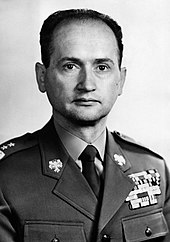
Wojciech Jaruzelski

Lech Wałęsa
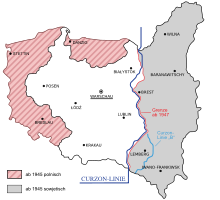
Westward shift of Poland
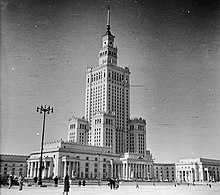
Stalin Palace 1960

Warsaw Uprising 1944
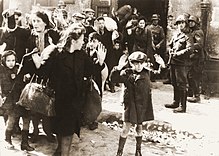
Warsaw Ghetto Uprising 1943. The photograph of the boy, taken from the Stroop report, is one of the most famous photographs of the Holocaust.

Nazi extermination camp

Bronze Age Biskupin
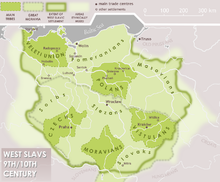
West Slavic tribes
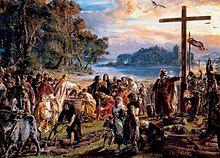
Matejko's baptism of Poland 966
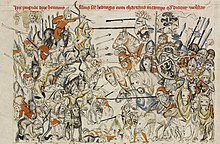
Battle of Liegnitz 1241
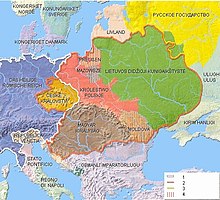
Jagiellonian power area around 1500
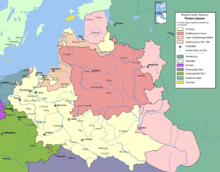
Poland-Lithuania around 1670

Divisions 1772, 1793, 1795
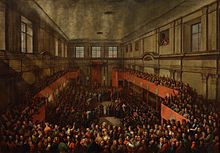
May 3 Constitution

Stanislaus II August Poniatowski
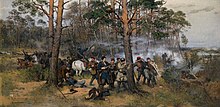
Ajdukiewicz's January Uprising

Warsaw Kronenberg Palace
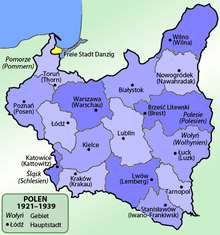
Poland after the Peace of Riga

Józef Piłsudski
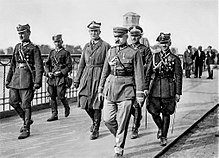
May Day Putsch 1926
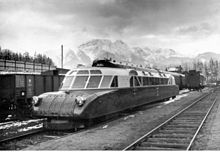
Luxtorpeda in Zakopane 1936
Politics
→ Main article: Polish political system
The Republic of Poland is a parliamentary democracy. The currently valid state organization law is codified primarily in the 1997 constitution. By European standards, the Polish system of government contains numerous elements of direct democracy.
Constitution
The first modern Polish constitution was adopted by the Great Sejm on May 3, 1791. The constitution currently in force was adopted by the National Assembly on April 2, 1997 and approved in a referendum on May 25, 1997 by Poles eligible to vote. Although 53.45 % of those who participated in the referendum voted in favor of the constitution, the turnout was only 42.86 %. Thus, only about one in five of those eligible to vote in the referendum voted for the constitution. The constitution entered into force on October 17, 1997. It contains 243 articles and is thus significantly longer than the constitutions of the Federal Republic or the USA.
See also: Constitutional history of Poland
Legislative
The Polish Parliament is one of the oldest parliaments in the world and has existed - in various forms as a three-chamber parliament and with interruptions - since 1493. The Parliament consists of two chambers, the Sejm and the Senate. The Sejm, together with the Senate, holds the legislative power. The political parties represented in Parliament are grouped as factions into a government and the opposition. The Sejm deputies and senators meet in the National Assembly on special occasions.
Sejm
The Sejm is composed of 460 deputies. It decides on its rules of procedure. The Sejm is headed by the Sejm Marshal. The Sejm Marshal is formally the second highest political office in the Republic of Poland after the Head of State. The Sejm has its seat in the Warsaw government district. Deputies are elected for a four-year term by proportional representation in a general and secret ballot. There is a 5% threshold for parties and an 8% threshold for electoral alliances. Seats in the Sejm are allocated according to the D'Hondt method. There are no overhang mandates under Polish electoral law. Fifteen deputies are required to form a parliamentary group in the Sejm. The Sejm convenes (investigative) committees. In 2017, there were 25 committees in the Sejm. Deputies enjoy immunity.
Senate
The Senate is composed of 100 deputies. It decides on its rules of procedure. The Senate is headed by the Senate Marshal. The Senate Marshal is formally the third highest political office in the Republic of Poland after the Head of State and the Sejm Marshal. The Senate is headquartered in Warsaw's government district. Senators are elected for a four-year term by universal suffrage and secret ballot in one hundred constituencies. The Senate appoints (investigative) committees. There were 14 committees in the Senate in 2017. Senators enjoy immunity.
Legislative procedure
The right to initiate legislation is vested in the President, the Government, the Senate, a group of at least 15 deputies or citizens (legislative initiative must be signed by 100,000 citizens). The draft law must be forwarded to the Sejm Marshal. The Sejm Marshal organizes three readings and discussions in the Sejm. A bill adopted by the Sejm is forwarded to the Senate. A Senate veto may be overridden by the Sejm if at least half of the statutory number of Deputies participate in the vote. A bill passed by the Sejm is sent to the President, who may sign it, return it to the Sejm (veto it), or refer it to the Constitutional Tribunal for review of its constitutionality. A veto by the President may be rejected by the Sejm by a three-fifths majority of the votes cast if at least half of the statutory number of Deputies participate in the vote. Adopted laws shall be published in the Journal of Laws of the Republic of Poland.
See also: Legislative procedure (Poland)
Direct democracy
The Polish Constitution provides for referendums at the national and local levels. Referendums at the national level can initiate:
- the Sejm
- the senate
- the government
- the citizens (500,000 signatures are required for this)
- the president
Referendums at the national level may be held on all matters of national concern, with the exception of regulations on fiscal, defense and amnesty issues. Referendum results are binding if at least half of those entitled to vote take part in the referendum. The referendum to approve the currently valid constitution did not meet this criterion, as only about 42 % of those entitled to vote took part in the referendum.
Legal system
Poland has a continental European codified legal system with large codes in the main areas of law, including the Civil Code, the Labor Code, and the Criminal Code.
Executive
The organs of the executive branch are the president, who is also head of state, and the Council of Ministers, which is headed by the prime minister. The constitution of July 1997 does not clearly delineate the powers of the president and the Council of Ministers. There is overlap, particularly in the areas of foreign and defense policy.
President
The president is elected directly by the people every five years. If no candidate receives more than half of the votes cast in the first round, a runoff election is held between the two candidates who received the most votes. A single re-election is possible. The presidential election on May 24, 2015 was won by Andrzej Duda, who was nominated by the Law and Justice Party. He was sworn in on August 6, 2015.
See also: President of the Republic (Poland)
Council of Ministers
The prime minister and all other members of the Council of Ministers are appointed by the president. The Prime Minister is confirmed by the Sejm after an exposé by a vote of confidence in which more than half of the voting deputies must express their confidence in him/her, with a quorum of at least half of the statutory number of deputies. The members of the Council of Ministers confirmed by the Sejm are sworn in by the President. The Council of Ministers is composed of the Prime Minister, Deputy Prime Ministers, Ministers and Committee Chairmen.
See also: Polish Government and Prime Minister (Poland)
Judiciary
Jurisdiction in Poland is basically divided into ordinary (sądownictwo powszechne) and administrative (sądownictwo administracyjne). The jurisdictions have two instances. The highest court is the Supreme Court in the ordinary jurisdiction and the Supreme Administrative Court in the administrative jurisdiction, both located in Warsaw. Also located in Warsaw are the Constitutional Tribunal, which administers justice in constitutional matters, and the State Tribunal.
instances of ordinary jurisdiction:
- Rejon dishes (sądy rejonowe)
- County courts (sądy okręgowe)
- Courts of appeal (sądy apelacyjne)
- Supreme Court (Sąd Najwyższy), which consists of five chambers, including, among others, the Disciplinary Chamber, whose status is under review by the Court of Justice of the EU (C-791/19).
As a rule, the court of first instance is the Rejon Court, and its decision may be appealed to the District Court. However, if the court of first instance is the district court, the appeal serves the appellate court. Annulments and cassation appeals - which, however, cannot be called the next, third instance - are always decided by the Supreme Court.
Instances of administrative jurisdiction:
- Voivodeship Administrative Court (Wojewódzkie Sądy Administracyjne)
- Supreme Administrative Court (Naczelny Sąd Administracyjny)
There are no separate labor, social and financial courts in Poland. Legal disputes in labor law are handled by the ordinary courts, while legal disputes in social and financial law are handled by the administrative courts. There is also a separate military jurisdiction. Private arbitration courts are permitted. For example, the German-Polish Chamber of Industry and Commerce has an arbitration court in Warsaw.
See also
- Criminal law (Poland)
- Civil law (Poland)
- Family Law (Poland)
Political indices
| Political indices published by non-governmental organizations | ||||
| Index name | Index value | Global rank | Interpretation aid | Year |
| Fragile States Index | 41 from 120 | 145 from 178 | Stability of the country: more stable | 2020 |
| Democracy Index | 6.85 from 10 | 50 from 167 | Incomplete democracy | 2020 |
| Freedom in the World Index | 84 from 100 | - — | Freedom status: free | 2020 |
| Press Freedom Ranking | 28.84 from 100 | 64 from 180 | Identifiable problems for press freedom | 2021 |
| Corruption Perception Index (CPI) | 56 from 100 | 45 from 180 | 0 = very corrupt / 100 = very clean | 2020 |
Parties
While in the 16th and 17th centuries associations of deputies in the Polish Sejm were spontaneous and mostly served only the election of a king or the assertion of short-term interests within the framework of a confederation, the first permanent parties established themselves at the beginning of the 18th century. In particular, the Familia around the magnate families of Czartoryski and Poniatowski and the competing Hetman party around the magnate families of Branicki and Potocki, as well as the Kamaryla Mniszcha around Jerzy August Mniszech, and in the second half of the century the parties of the Jakubins, the Patriots and the Constitutional Party, which were formed in the course of the reforms of the Great Sejm. Modern parties emerged during the partition period in the 19th century in the parts of the country belonging to Prussia, Austria and Russia. The number of parties was correspondingly large at the beginning of the Second Polish Republic after gaining independence. After the Soviet occupation in 1939/1944, a one-party system was introduced along Russian lines, although there were still two sham parties that played no political role. After 1989, numerous small parties emerged from the Solidarność movement and the post-communists. After the turn of the millennium, some of these microparties united to form the current leading parties in the Polish Sejm. In 2017, 85 political parties were registered in Poland. The Constitution and the Law on Political Parties regulate the rights and duties of political parties.
See also: Parties in Poland
Parliamentary parties
| Parties represented in the Sejm and the Senate since the 2019 parliamentary elections | |||||||
| Party | Sejm | Senate |
| ||||
| Voices | % | Seats | Kandi-data | Seats |
| ||
| Prawo i Sprawiedliwość (PiS+P+SP) | 8.051.935 | 43,59 | 235 | 91 | 48 |
| |
| Koalicja Obywatelska (PO+.N+Zieloni) | 5.060.355 | 27,40 | 134 | 68 | 43 |
| |
| Lewica (SLD+Wiosna+razem) | 2.319.946 | 12,56 | 49 | 6 | 2 |
| |
| Polskie Stronnictwo Ludowe (PSL+Kukiz'15) | 1.578.523 | 8,55 | 30 | 15 | 3 |
| |
| Konfederacja (KORWiN+RN) | 1.256.953 | 6,81 | 11 | 7 | - – |
| |
| Election Committee German Minority | 32.094 | 0,17 | 1 | 3 | - – |
| |
| Source: Państwowa Komisja Wyborcza (PKW; National Election Commission), October 15, 201 |
| ||||||
Top politicians
One of the criticisms of the 1997 constitution is that the hierarchy of politicians it prescribes does not reflect the actual balance of political power. Formally, the President of the Republic, followed by the Marshal of the Sejm and the Marshal of the Senate, are the most important politicians in Poland. De facto, however, current policy is determined by the prime minister, who ranks only fourth in the formal order of precedence. The leader of the governing party or coalition is not without political influence, as the parliamentary majority can recall the prime minister at any time.
· 
Sejm Marshal Elżbieta Witek
· 
Senate Marshal Tomasz Grodzki
· 
Prime Minister Mateusz Morawiecki
·
Coalition Chairman Jarosław Kaczyński
Foreign Policy
→ Main article: Foreign policy of Poland
The foreign policy of the Third Republic is determined by Poland's history and geopolitical situation. The Minister of Foreign Affairs, currently Jacek Czaputowicz, is responsible, supported by the President.
Because of its long experience of foreign domination, Poland's foreign policy is oriented toward sovereignty that is as unrestricted as possible. In the EU, Poland seeks a high degree of autonomy.
Poland is a founding member of numerous international organizations, including: United Nations, Central European Free Trade Agreement (up to and including 2004), Council of Baltic Sea States, Visegrád Group, Weimar Triangle or Kaliningrad Triangle. Poland continues to be a member of: European Union, NATO, World Trade Organization, Organization for Economic Cooperation and Development, European Economic Area, International Energy Agency, Council of Europe, Organization for Security and Cooperation in Europe, International Atomic Energy Agency, European Space Agency, European Southern Observatory, G6 of the European Union, Community of Democracies, Central European Initiative, Three Seas Initiative, Baltic Sea Nature Conservation Organization, and all sub-organizations of the UN. Poland has observer status in the following organizations: Arctic Council and International Organization of French-Speaking Countries. Poland is a member of the Schengen area and a candidate for joining the Eurozone. The European Border and Coast Guard Agency - Frontex is based in Poland.
See also: List of Polish Foreign Ministers and Polish European Policy
The Poles see the United States as their most important ally. US troops have been stationed on Polish territory since 2016.
In the east, Poland sees itself as bound to Lithuania, Belarus and Ukraine, with which it formed the Polish-Lithuanian noble republic for centuries. Poland sees itself as Ukraine's advocate in its relations with NATO and the EU.
Already the noble republic Poland maintained diplomatic relations with Persia and the Ottoman Empire, which in return never recognized the partitions of Poland and asked for the Polish envoy at every international conference.
The noble republic also maintained good relations with France and the Papal States.
In the first half of the 20th century, the Second Republic developed a good relationship with Great Britain, which provided a guarantee for Poland in the run-up to World War II.
Relations with Germany and Russia, on the other hand, have been strained since the partitions of Poland - with the exception of the period of Polish enthusiasm (e.g. Hambach Festival) of the pre-March period - and especially because of World War II and the subsequent dependence on the Soviet Union. Interestingly, relations with Austria, which also participated in the partitions of Poland and the invasion of Poland, are much more relaxed. In contrast, relations with Switzerland, which supported Poland abroad during the partition period, are friendly.
Poland shares a particularly friendly relationship with Hungary that dates back to the High Middle Ages, when the two kingdoms were ruled three times in personal union. Poland and Hungary work closely together with the Czech Republic and Slovakia in the Visegrád Group.
There are also traditionally good relations with the other states of the Three Seas Initiative.
See also: List of Polish diplomatic missions abroad and List of diplomatic missions in Poland
Military
→ Main article: Polish Armed Forces
According to the Global Firepower ranking (2016), Poland has the 18th strongest army in the world and the 5th strongest in Europe. The defense budget in 2016 was $9.7 billion, or about 2% of Poland's GDP, making Poland one of the few countries to meet NATO requirements in this regard. Poland is currently modernizing its armed forces. In the wake of the Ukraine crisis, Poland has intensified this process. The defense budget is to be increased to 2.5% of Poland's GDP and the number of soldiers to 200,000. Poland has announced that it will spend more than 30 billion euros on the procurement of new weapons systems by 2022.
The President is the supreme commander of the Polish armed forces. However, the military reports directly to the Minister of Defense and consists of the Air Force, Navy, Land Forces, Special Forces and Territorial Defense.
See also: Polish General Staff and ranks of the Polish Armed Forces
Historical development
In the times of the noble republic, conscription existed only for the szlachta for defensive warfare. Known in history are especially the Polish Hussaria and the Uhlans, who distinguished themselves in the Swedish and Turkish wars.
One of the reforms of the Great Sejm at the end of the 18th century was the introduction of a standing army of 100,000 men, but its organization did not happen due to the second and third Polish partitions.
During the Napoleonic Wars, Polish legions were formed in Italy and France. The Grand Duchy provided a large part of the soldiers who took part in Napoleon's Russian campaign in 1812.
The modern Polish Army was formed during World War I from the Polish Armed Forces and the Polish Legions, and later in the Second Republic during the Polish-Soviet War, with initially over 800,000 soldiers.
In the People's Republic, the Polish armed forces were under the Soviet leadership within the Warsaw Pact.
After 1989, the military was reformed, the number of soldiers was reduced from over 500,000 to 150,000 soldiers (plus 450,000 reserve soldiers), and equipment was modernized. The Polish armed forces have the latest weaponry, such as American F-16s, modern Israeli anti-tank guided missiles, and Finnish Patria AMV 8×8s. In addition, Polish weapons producers have been brought up to date by offset investments from the Americans and are successfully exporting heavy warfare equipment worldwide. A new elite unit, the GROM unit, was introduced in the 1990s.
In March 1999, Poland joined NATO after having participated in its Partnership for Peace program since 1994.
On November 13, 2006, an agreement was signed with Germany, Latvia, Lithuania and Slovakia to form a joint EU task force. Poland took over the overall command and provided about 1500 soldiers.
Until 2008, conscription was compulsory for men in Poland.
Polish military units were deployed abroad in 2010 in Afghanistan (2600 soldiers), Kosovo (320), Bosnia andHerzegovina (204) and Iraq (20).
See also: Polish People's Army and Polish Army before World War II
Air Force
The air force has nearly 200 combat aircraft, including 48 F-16 multirole fighters, 36 MiG-29 multirole fighters and 48 Sukhoi Su-22 bombers, and about 250 attack helicopters. There are plans to acquire about 50 more combat helicopters.
See also: Polish Air Force
Marine
The Polish Navy has two frigates, one corvette, three speedboats, five submarines, several training and support vessels, as well as one aircraft and five helicopters. There are plans to expand the submarine fleet.
See also: Polish Navy
Land Forces
Poland currently has about 120,000 soldiers and 500,000 reservists. The backbone of the land forces is formed by 1065 main battle tanks, including 249 Leopard 2, 232 PT-91 and 528 T-72, as well as several thousand infantry fighting vehicles and other armored vehicles, including in particular 1268 BMP-1, 690 KTO Rosomak, 237 BRDM-2, 28 Bergepanzer 2, 74 WPT Mors, 90 TRI, 5 KTO Ryś, 70 D-44, 27 9P148 "Malyutka," 217 HMMWV, 75 WR-40 Langusta, 75 BM-21, 120 AHS Krab, 111 DANA, 342 2S1, 20 ZSU-23-4MP Biała, 64 9K33 Osa, and ca. 200 combat helicopters.
See also: Polish Land Forces
Special Forces
The Polish special forces have over 2250 elite soldiers. The best known special unit is the GROM.
See also: Polish Special Forces
Territorial defense
The Territorial Defense Units (WOT) were introduced in 2017 in response to the war in Ukraine. Currently, about 8,000 soldiers serve in this unit. The plan is to expand the territorial defense to 50,000 soldiers.
See also: Territorial defense army
Management
Management structure
→ Main article: Administrative division of Poland
Since January 1, 1999, Poland has been divided into 16 voivodeships (województwo), which refer to the historical regions of Poland. The smallest voivodeship - Opole - is only about 10,000 square kilometers, while the area of the largest voivodeship - Mazovia - is 3.5 times larger. There are also big differences in terms of the number of inhabitants. While Mazovia voivodeship has almost 5.5 million inhabitants, Opole voivodeship has less than one million people. A reform of the voivodeships is being discussed; in particular, it is being considered to form a voivodeship of Central Pomerania from the peripheral areas of the voivodeships of Pomerania and West Pomerania, as well as to spin off the metropolitan region of Warsaw from the voivodeship of Mazovia. There is also talk of splitting the Opole Voivodeship into the Lower Silesia and Silesia Voivodeships.
Poland is a central state. The autonomy of the voivodeships is limited. In particular, the voivodeships have only very limited legislative competence.
Each voivodeship has its own self-governing body, the Voivodeship Sejmik (sejmik województwa) and a Voivodeship Board (zarząd województwa) elected by them under the Voivodeship Marshal (marszałek województwa) as chairman. The voivode (wojewoda), on the other hand, is a representative of the central government in Warsaw and is responsible for controlling the self-government of the voivodeships, counties (powiat) and municipalities (gmina).
Voivodeships are divided into counties, which in turn are divided into municipalities. A distinction is made between rural municipalities, urban municipalities and mixed urban-rural municipalities. Larger cities usually have the status of both a municipality and a county, i.e. they are county-free. Larger municipalities, in turn, are divided into shulzenämter, quarters, settlements, or colonies. In 2016, Poland had sixteen voivodeships, 380 counties and almost 2500 municipalities.
| Coat of arms | Flag | German name | Polish name | Capital / Capitals | Population 2016 |
|
|
| Warmia-Masuria Voivodeship | Województwo warmińsko-mazurskie | Allenstein | 1.436.367 |
|
|
| Wielkopolska Voivodeship | Województwo wielkopolskie | Posen | 3.481.625 |
|
|
| Voivodeship Holy Cross | Województwo świętokrzyskie | Kielce | 1.252.900 |
|
|
| Voivodeship Carpathian Foothills | Województwo podkarpackie | Rzeszów | 2.127.656 |
|
|
| Lesser Poland Voivodeship | Województwo małopolskie | Krakow | 3.382.260 |
|
|
| Kujawsko-Pomorskie Voivodeship | Województwo kujawsko-pomorskie | Thorn and Bydgoszcz | 2.083.927 |
|
|
| Lubuskie Voivodeship | Województwo lubuskie | Landsberg an der Warthe and Grünberg | 1.017.376 |
|
|
| Voivodeship Łódź | Województwo łódzkie | Lodsch | 2.485.323 |
|
|
| Lublin Voivodeship | Województwo lubelskie | Lublin | 2.133.340 |
|
|
| Mazowieckie Voivodeship | Województwo mazowieckie | Warsaw | 5.365.898 |
|
|
| Lower Silesia Voivodeship | Województwo dolnośląskie | Wroclaw | 2.903.710 |
|
|
| Opole Voivodeship | Województwo opolskie | Opole | 993.036 |
|
|
| Podlaskie Voivodeship | Województwo podlaskie | Białystok | 1.186.625 |
|
|
| Pomeranian Voivodeship | Województwo pomorskie | Gdansk | 2.315.611 |
|
|
| Voivodeship Silesia | Województwo śląskie | Katowice | 4.559.164 |
|
|
| West Pomeranian Voivodeship | Województwo zachodniopomorskie | Szczecin | 1.708.174 |
See also: List of municipalities in Poland and Sołectwo
Cities
→ Main article: List of cities in Poland
In ancient times, the settlements Calisia and Turso were mentioned on the present territory of Poland. It is assumed that these places are the same as today's towns Kalisz and Elbląg. The pile-dwelling settlement of Biskupin dates back to the 8th century BC. Slavic settlements were established around the 6th century AD, mainly on easily protected lake and river islands around wooden castles of the respective tribal lords. From the 13th century onwards, many settlements were granted a town charter according to the Magdeburg, Lübeck or Kulm model. In the High Middle Ages, many towns joined the Hanseatic League or other associations of towns. After the political weight shifted from the towns to the nobility in the noble republic, many towns lost their importance in the 18th century. With the reforms of the Great Sejm at the end of the 18th century, the bourgeoisie regained importance over the nobility. However, the reforms did not last because of the last two Polish partitions. Modern Polish cities emerged in the course of industrialization in the 19th century.
According to the Main Statistical Office, there were 919 cities in Poland in 2016. About 40 cities in Poland have a population of more than 100,000 and are thus considered large cities. The smallest city Wyśmierzyce had 921 inhabitants and Warsaw as the most populous city had almost 2000 times more. The smallest city in terms of area was Stawiszyn with 0.99 km² and the largest was Warsaw with 517.24 km². The lowest population density was Krynica Morska with 12 persons/km² and the highest was Legionowo with 3996 persons/km².
The largest cities in Poland are Warsaw, Krakow, Łódź, Wroclaw, Poznan, Gdansk, Szczecin, Bydgoszcz and Lublin. The largest agglomerations are the Warsaw metropolitan area, the regions around Katowice, Łódź, Kraków and the so-called "Tri-City" with Gdansk, Sopot and Gdynia. 60.5% of the Polish population lives in cities, making Poland one of the less urbanized countries in Europe.
See also: List of Polish capitals

In 2017, the EU agency Frontex moved from Rondo 1-B to the East Tower of Warsaw Spire in Warsaw

Constitutional Court
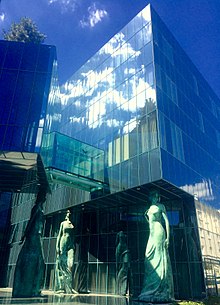
Supreme court
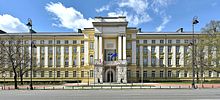
Chancellery of the Prime Minister

Presidential Palace

Plenary hall of the Senate
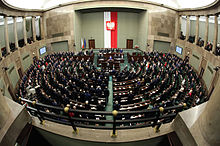
Plenary Hall of the Sejm

Polish political system
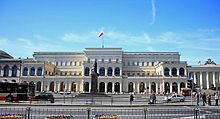
Mazowieckie Voivodeship Office
.jpg)
Lesser Poland Voivodeship Office
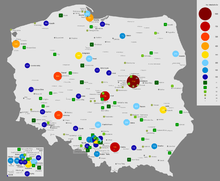
The largest cities in Poland
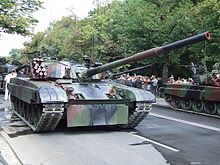
PT91 Twardy
.jpg)
F-16 Jastrząb
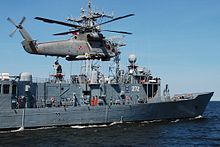
ORP Generał Pułaski
.jpg)
Special Forces
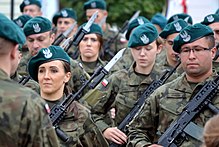
Swearing WOT unit

Polish voivodeships
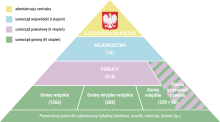
Scheme of the administrative division
.jpg)
Exercise near Drawsko Pomorskie

The administrative division of Poland
Economy and infrastructure
→ Main article: Economy of Poland and Złoty
As of April 2021, Poland's economy ranked 22nd in the world in terms of both gross domestic product ($642.120 billion) and purchasing power parity ($1.363 billion) (both in nominal terms).
Since the end of socialism, the Polish economy has been able to develop comparatively well. Poland has been able to record consistently positive economic growth in recent years. Poland was the only European country not to experience a recession as a result of the global crisis (2008). Since 2013, the economy has continued to recover, driven by domestic demand, especially investment and consumption. In 2017, gross domestic product (GDP) increased by 4.6 percent year-on-year. Growth is supported by business-friendly policies, fiscal policy stability, flexible labor laws, consistent use of EU funding for infrastructure development and, last but not least, substantial foreign direct investment. In comparison with the GDP of the EU expressed in purchasing power standards, Poland achieved an index value of 69 (EU-28:100) in 2015, about 55% of the German value.
Gross domestic product is distributed very differently from region to region. In 2017, the richest voivodeships (compared to the national average) continued to be Mazovia with 160.5% (Comp. 2009: 133% of the national average) and Lower Silesia with 110.5% (114%), and the poorest voivodeships were Lublin with 69% (68%), Carpathian Foothills with 69.7% (71%) and Warmia-Masuria with 70.1%. Unemployment was about 6.6% in December 2017, and the number of registered unemployed was 1.08 million.In the Global Competitiveness Index, which measures a country's competitiveness, Poland ranked 39th out of 137 countries (as of 2017-2018). In the Economic Freedom Index, Poland ranked 45th out of 180 countries in 2017. Poland is a largely open economy that benefits greatly from free trade in the European Union.
Average gross monthly wages in 2019 were PLN 5,181.63 (EUR 1,155.76 as of June 1, 2021). In the richest voivodeship, Mazovia, the average gross wage in 2019 was PLN 6,248.47 (EUR 1,393.71), where as in the poorest voivodeship, Lublin, the gross wage was PLN 4,564.85 (EUR 1,018.18).
While inflation was 2.581% in 2010, deflation has prevailed in Poland since mid-2014.
State budget
In 2017, the state budget included expenditures of PLN 375.9 billion, which were offset by revenues of PLN 350.5 billion. This results in a budget deficit of PLN 25.4 billion.
Public debt was 52% of GDP in the third quarter of 2017, well below the EU average of 82.5% and the eurozone of 88.1%.
The share of government spending (as a % of GDP) of the following areas in recent years was:
- Health - 6.4 % (2013)
- Education - 5 % (2014)
- Military - 2 % (2016)
Taxes
In Poland, taxes are levied at the national and regional levels. The most important taxes are national taxes, in particular income tax, corporate income tax and sales tax. Apart from VAT, Polish tax rates are relatively low by international standards.
Poland levies a linear income tax with three tax rates of 0% (basic exemption amount), 18% and 32%. The top Polish income tax rate is thus 32% and is relatively low by international standards. Entrepreneurs also have the option of paying a linear income tax rate of 19 % if they submit a simplified tax return in which they waive the claiming of certain income-related expenses.
There is no trade tax in Poland. Likewise, no church tax or solidarity surcharge is levied.
Corporate income tax is levied on the income of corporations. The tax rate is 15% for small corporations and 19% for large corporations.
There is no property tax in Poland. However, municipalities levy a property tax on real estate located within them.
The VAT rates are 0%, 5%, 7%, 8% and 23%. Certain transactions that are not subject to sales tax are taxed with a transaction tax with tax rates ranging from 0.1% to 2%.
Poland has concluded a double taxation treaty with most countries to avoid double taxation in the field of income taxation.
Foreign Trade
In 2016, exports totaled 183.0 billion euros and imports 178.2 billion euros. As Poland is a favorable production location for foreign companies, it now has a positive trade balance. Germany represented the largest trading partner, accounting for 27.4% of exports and 28.3% of imports. Other important trading partners are the EU states Italy, France, the United Kingdom, the Netherlands and the Czech Republic, as well as Russia, the People's Republic of China and the USA.
| Export (in percent) to | Import (in percent) from | ||
| Germany | 27,4 | Germany | 28,3 |
| United Kingdom | 6,6 | China People's Republic of | 7,9 |
| Czech Republic Czech Republic | 6,6 | Netherlands | 6,0 |
| France | 5,4 | Russia | 5,8 |
| Italy | 4,8 | Italy | 5,3 |
| Netherlands | 4,5 | France | 4,2 |
| Sweden | 2,9 | Czech Republic Czech Republic | 4,1 |
| other countries | 41,8 | other countries | 38,4 |
Labor market
In spring 2019, the unemployment rate was 5.9% according to CIS, which accounted for just under one million people of working age, and 3.5% according to Eurostat. Previously, in October 2012, according to the Polish Main Statistical Office, unemployment was 12.5%.
Unemployment in Poland is distributed very differently from region to region. In the cities of Poznan and Warsaw, there is practically full employment, while in the rural regions of Warmia-Masuria, on the other hand, unemployment was 11.8% in September 2017, according to CIS In November 2006, 13.2% of the registered unemployed received unemployment benefits. About 12% of the workforce was employed in agriculture in 2013, which is a lot in relation to the EU average (5%). 30.3% are employed in industry and 57.8% in services. About one-third of jobs are found in the public sector.
Energy supply
![]()
Parts of this article seem to be out of date since 2013.
Please help to research and insert the missing information.
Wikipedia:WikiProject events/past/2013
Gross electricity generation by Polish power plants was around 160 TWh in 2012. Electricity supply in Poland is largely based on the generation of electricity from hard coal and lignite, which together supplied 88.6% of Poland's electricity in 2012. The most important mining company is the state-owned Kompania Węglowa. Gas-fired power plants were largely insignificant, and renewables met 8.7% of electricity demand, with biomass ahead of fast-growing wind and hydropower. Poland has rich deposits of geothermal energy, which is currently being increasingly used in Kujawy near Thorn and in the Podhale mountain region near Zakopane. At 16.6 %, the share of cogeneration in total generation is at a relatively high level. Due to the very high share of conventional energy sources, Polish politicians are lobbying against ambitious climate protection targets out of concern about potentially high costs. Polish policy also relies on coal-fired power in order to be as independent as possible from energy imports.
The country does not yet have any commercially operated nuclear power plants, but it does operate a small experimental reactor with a thermal output of 30 MW, the Maria research reactor, which went critical on December 18, 1974. This currently operates at only two-thirds capacity. Uranium mining was carried out in the southwest of the country until 1968. Planning for new nuclear power plants was suspended in June 2013. The reason given for the step was that the costs were too high.
See also: List of power plants in Poland
Company
| Top ten listed Polish companies in terms of sales in 2016 | |||||
| Logo | Company | Industry | Seat | Turnover | Employees |
|
| PKN Orlen SA | Raw materials | Płock | 79.553 | 4.445 |
|
| PGNiG | Raw materials | Gdansk | 33.196 | 5.168 |
|
| PGE SA | Energy | Warsaw | 28.092 | 44.317 |
|
| PZU SA | Insurance | Warsaw | 22.212 | 36.419 |
|
| Grupa Lotos SA | Raw materials | Gdansk | 20.931 | 33.071 |
|
| KGHM Polska Miedź SA | Raw materials | Lubin | 19.556 | 18.578 |
|
| Tauron Group SA | Energy | Katowice | 17.646 | 26.710 |
| Cinkciarz.pl Sp. z o.o. | Credit institution | Zielona Góra | 14.283 | 22.556 | |
|
| PKO BP | Credit institution | Warsaw | 13.544 | 5.303 |
|
| Enea S.A. | Energy | Posen | 11.255 | 23.805 |
Poland's economy is considered a regional leader in Central and Eastern Europe with 40% of the region's top 500 listed companies in terms of turnover based in Poland.
See also: List of the largest companies in Poland
Tourism
→ Main article: Tourism in Poland
Tourism is a significant factor in service sector revenues. According to the World Tourism Organization, Poland is the 16th most popular destination among international tourists. In 2015, more than 16.7 million foreign tourists came to Poland, which represented an increase of 4.6% compared to the previous year. The tourism sector accounted for a volume of almost $10 billion in 2015. In 2016, the number of arrivals to Poland amounted to 80.5 million, of which approximately 17.5 million can be considered tourist.
The most popular tourist destination in Poland is the former capital Krakow, which has numerous architectural monuments and works of art from the Polish Golden Age of late Gothic and Renaissance. Important tourist destinations are also the cities of Warsaw, Wroclaw, Gdansk, Poznan, Szczecin, Lublin, Thorn and Zakopane. Tourism also plays an important role for the municipalities of Krynica-Zdrój, Karpacz, Szklarska Poręba, Biecz, Zamość, Sandomierz, Kazimierz Dolny, Czestochowa, Gniezno, Frombork, Malbork, Gdynia, Sopot, Kołobrzeg, Świnoujście and Międzyzdroje. Many cities offer tourist services for families with children, such as Wroclaw with the Wroclaw Dwarfs, Warsaw, Kielce, Gdansk and Szczecin. Some smaller towns in Poland are members of the association Cittàslow, which focus on balanced tourism.
Visitor magnets are: The Wieliczka Salt Mine, the museum in the birthplace of FryderykChopin in Żelazowa Wola near Sochaczew, the memorial site of the Auschwitz-Birkenau concentration camp, the coast of the Baltic Sea, the large sea plates in Wielkopolska, Masuria, Kashubia and Suwalki, as well as the mountain ranges of the Sudetes and Carpathians, especially the Tatras with the High Tatras and Western Tatras, where the highest peak in Poland Meeraugspitze and the famous Orla Perć high trail are located. Popular recreational areas are also the Holy Cross Mountains, Beskydy, Pieniny, Cracow-Czestochowa Jura and Roztocze, as well as Szczecin and Vistula Lagoon.
The Polish Mountain Club PTTK operates about 200 shelters and mountain huts in the Polish mountains and maintains 63,000 kilometers of (long-distance) hiking trails, of which the Beskydy Main Trail, the Sudety Main Trail, the Pieniny Trail and the Polish-Czech Friendship Trail are the best known.
World Heritage in Poland includes fifteen positions, among which are the old cities of Krakow, Warsaw, Thorn and Zamość.
Poland has 23 national parks that are open to tourists except for strictly protected nature reserves. With three million visitors, the Tatra National Park is the most popular.
Bicycle tourism is also becoming increasingly popular in Poland, for example, the Green Velo eastern cycling route.
On rivers and waterways there are many waterways for kayaking, canoeing, sailing and houseboats, for example on the Pilica, Krutynia or Czarna Hańcza.
There are numerous ski resorts in the Carpathians and Sudetes, most of them in and around Zakopane in the Tatras and Szczyrk in the Silesian Beskids, and Karpacz in the Krkonoše Mountains.
Spa vacations are also popular in the numerous spas such as Połczyn-Zdrój or Ciechocinek.
Thermal spas, which have been opened in recent years, especially in the Podhale mountain region near Zakopane, are becoming increasingly popular.
There are over a hundred preserved medieval castles and palaces in Poland, including Eagle's Nest, Dunajec Castle and Teutonic Order Castle. Renaissance and Baroque palaces can be found mainly in eastern Poland and Warsaw. Manors of the Polish lesser nobility, on the other hand, are scattered all over the country.
Traffic
→ Main article: Transport in Poland
Poland is an important transit country from Northern Europe to Southern Europe and from Western Europe to Eastern Europe. Already in ancient times and in the Middle Ages important trade routes led through today's Poland, such as the Amber Roads, the European section of the Silk Road, the trade route from Western Europe to Asia.
Road traffic
The road network has a total length of about 382,000 km, including about 1374 km of highways and another 1050 km of expressways.
In 2007, the Polish highway network was still two and a half times smaller than that of Switzerland. From 2007 to 2012, the highway network was almost doubled, with a total of 672.5 kilometers added. When fully expanded, the network should amount to just under 2,000 kilometers. The network of expressways totaled 266.2 kilometers in 2006. In the six years from 2007 to 2012, 854 kilometers were completed and the expressway network was increased fivefold. The network of expressways is expected to total 5500 km.
18,368 km of state roads (Polish: droga krajowa) - similar to the German federal roads - serve national and international traffic. As of January 1, 1999, 28,444 km of state roads were downgraded to voivodeship roads (poln: droga wojewódzka). In addition, there are 128,870 km of county roads (poln: droga powiatowa) and 203,773 km of municipal roads (poln: droga gminna).
More than 12 million passenger cars and 2 million trucks and other commercial vehicles are registered in Poland. In total, 383 passenger cars were registered per 1,000 inhabitants at the end of 2007, compared with an EU average of 486. In 2017, around 350,000 old diesel vehicles were imported, most of them from Germany. And this despite the fact that, according to the WHO, in the same year 33 of the 50 European cities with the highest levels of air pollution were in Poland.
An extensive intercity bus network serves public transport, which is still very important in Poland despite the growth in private transport. Throughout the country, bus transport plays a more important role than rail transport.
In 2004, 5700 people died in traffic accidents in Poland, which means a rate four times higher than the EU average. However, this is already a reduction in the number, in 1999 there were 6730 deaths and in 1998 - 7080. Places with a high accident rate are often marked by a so-called black dot (czarny punkt).
Since April 14, 2007, it has been compulsory for cars and trucks to have their lights on all day and all year, with dipped or daytime running lights being mandatory. Since June 1, 2007, there has been an absolute ban on alcohol when driving motor vehicles, after a blood alcohol concentration of 0.2 per mille was permitted until then.
For freeways, expressways and state roads, a distance-based toll is payable for motor vehicles on selected road sections. For motor vehicles with a maximum permissible weight of more than 3.5 tons (including trucks), a system known as viaTOLL, operated by the state operator GDDKiA, and manual toll payment on the highway sections of private operators are possible. For motor vehicles with a gross vehicle weight of less than or equal to 3.5 tons (including passenger cars), there is a possibility of using the viaTOLL system or manual toll payment at the toll booths on the highway sections operated by GDDKiA. On highway sections operated by private operators, only manual toll payment is possible.
See also: Motorway (Poland)
Rail transport
Rail transport still plays an important role in Polish transportation, even after the strong growth of individual transport in the last two decades. The Polish railroad infrastructure company PKP PLK is one of the largest European railroad companies with over 23,420 km of rail network. At Poland's eastern border, the European standard gauge network meets the wider Russian track system.
See also: History of railroads in Poland and List of railroad lines in Poland
Air traffic
Poland has 14 airports, 123 national airfields and three helicopter bases. The number of passengers has increased rapidly in recent years. With regional airports already reaching capacity, a decision was made in 2017 to build a central airport between Warsaw and Łódź near Grodzisk Mazowiecki, which would have a capacity of approximately 50 million passengers annually, making it one of the largest airports in Europe.
See also: list of airports in Poland and list of airlines in Poland
Shipping
The overseas merchant fleet consists of over 100 ships. Seaports are located along the Baltic coast, with most cargo being transhipped in Gdansk, Szczecin-Swinemünde, Gdynia, Kołobrzeg and Elbląg. In addition, there is also the port of Police, which serves mainly the local chemical industry plants. Passenger ferries connect Poland with Scandinavia Passenger all year round. Polferries has its ports in Gdansk and Świnoujści, Stena Line in Gdynia and Unity Line in Świnoujście.
The following regular ferry connections exist:
- Gdansk to Nynäshamn (near Stockholm)
- Gdynia to Helsinki, Oxelösund and Malmö
- Swinoujscie to Copenhagen, Malmö, Rønne (only in summer) as well as Ystad
Inland navigation is being expanded. Poland has 3,812 kilometers of navigable rivers and canals, many of which are part of international waterways. The most important inland ports are located in Warsaw, Gliwice, Wroclaw and Krakow.
Local traffic
Local transport in Poland consists mainly of buses and streetcars. Warsaw also has a metro, and Kraków Łódź, Poznan, Wroclaw, Gdansk and Szczecin have a network of urban rapid transit systems. Lublin, Gdynia, Tychy and Sopot have trolley buses.
See also: Państwowa Komunikacja Samochodowa
Education
→ Main article: Education system in Poland
School system
The first modern Ministry of Education in the world was established in 1773 as part of the reforms in the spirit of the Enlightenment in the Polish-Lithuanian noble republic. Today's education system in Poland is in transition. After the fall of communism in 1989, there were two major reforms in 1999 and 2017. According to the new guidelines, grammar schools, which were introduced in 1999, are to be abolished by 2019. The school system will then consist of kindergartens, eight-year elementary schools and secondary schools such as four-year lyceums, five-year vocational high schools and other vocational schools. The baccalaureate will be taken after graduation from a lyceum or vocational high school. The baccalaureate examination is to become significantly more difficult again. Passing the baccalaureate exam is a prerequisite for studying at a university. Since 2017, parents have had the choice of having their children enrolled in school at age six or seven. State schools are free of charge, but school supplies such as books, notebooks, pencils or school bags must be paid for privately. The school year begins on September 1 and ends in the first half of June. The school vacations during the school year are decided by the individual voivodeships and are to be organized in a staggered manner so that not all children go skiing in the mountains at the same time, for example.
In the 2015 PISA ranking, Polish students achieved 17th place out of 72 countries in mathematics, 22nd place in science and 13th place in reading comprehension. Poland is thus above the average of the OWCE countries.
Universities
→ Main article: List of universities in Poland
The oldest Polish university and also the second oldest in Central Europe is the Jagiellonian University in Kraków, founded by Casimir the Great in 1364. The next four oldest Polish universities in Vilnius (1579), Zamość (1594), Raków (1602) and Lviv (1661) no longer exist or were moved to Wroclaw and Thorn after the end of World War II. There are almost two million students studying in Poland. Since the fall of communism in 1989, higher education institutions have been largely independent of instructions from the state regarding their educational offerings. In 2008, there were 130 state and 315 non-state higher education institutions in Poland. There were also 78 institutions of the Polska Akademia Nauk (Polish Academy of Sciences) and about 200 independent research institutions. Since the 1990s, state universities have faced increasing competition from private universities. Studies at state universities in Poland are generally free of charge in full-time programs. Part-time, weekend and distance learning courses as well as studies at private universities are subject to a fee. The universities award the designations Magister, Licencjat, Ingenieur, Doktor and Doktor hab. The Magister is awarded after a standard four- to five-year period of study, which ends with a thesis. In human medicine, the degree Arzt der Humanmedizin replaces the Magister; in veterinary medicine, the corresponding degree is called Arzt der Veterinärmedizin. In technical courses of study, the degree Magister is supplemented by the suffix Ingenieur.
| Coat of arms | Name | Dedication | Seat | Year established | Comment |
|
| Jagiellonian University | Jagiellonian | Krakow | 1364 | |
|
| University of Wroclaw | Wroclaw | 1702 | 1945 newly founded by professors of the | |
|
| Warsaw University | Warsaw | 1816 | ||
|
| Catholic University of Lublin | John Paul II | Lublin | 1918 | |
|
| Poznan University | Adam Mickiewicz | Posen | 1919 | |
|
| MCS University | Marie Curie-Skłodowska | Lublin | 1944 | |
|
| University of Thorn | Nicolaus Copernicus | Toruń | 1945 | Founded in 1945 by professors from |
|
| University of Łódź | Łódź | 1945 | ||
|
| Szczecin University | Szczecin | 1945 | ||
|
| Cardinal Stefan Wyszyński University | Cardinal Stefan Wyszyński | Warsaw | 1954 | |
|
| Katowice University | Katowice | 1968 | ||
|
| University of Bydgoszcz | Casimir the Great | Bydgoszcz | 1969 | |
| Kielce University | Jan Kochanowski | Kielce | 1969 | ||
|
| Gdansk University | Gdansk | 1970 | ||
|
| Opole University | Opole | 1994 | ||
|
| University of Białystok | Białystok | 1997 | ||
|
| University of Warmia-Masuria | Allenstein | 1999 | ||
|
| University of Rzeszów | Rzeszów | 2001 | ||
|
| University of Grünberg | Grünberg | 2001 | ||
|
| University of Social Sciences and Humanities SWPS | Warsaw | 2015 |
See also: Category:University in Poland
Science
Already with the foundation of the bishoprics in the year 1000, church schools were gradually opened at the bishoprics. With the Cistercian Order, Western science also came to Poland. As early as 1364 Casimir the Great founded Krakow University, which is the second oldest alma mater in Central Europe. It was the first university to have an independent professorship of mathematics and astronomy. Its rector Paweł Włodkowic - one of the most important international lawyers of that time - at the Council of Constance in 1415 put forward the thesis that pagan peoples had a right to their own state and should not be Christianized by the sword. That he did not have to share the fate of his Prague colleague Jan Hus was thanks to the numerous Polish knights who were present at the council.
Science in Poland reached its heyday during the Humanist period. One of Kraków's students was Nicolaus Copernicus, who, among other things, acquired here the mathematical and astronomical tools for his later development of the heliocentric view of the world. Important astronomers and mathematicians of that time were Marcin Król, Marcin Bylica, Marcin Biem, Johann von Glogau and Albert de Brudzewo. In (al)chemistry and medicine, Adam of Bochinia and Maciej Miechowita were leaders at that time. New universities were founded in Zamość, Raków, Vilnius, Poznań and Lviv, in addition to the numerous Jesuit schools. After the wars of the 17th century, however, Polish science visibly deteriorated and reached its nadir in the Saxon period. An exception was the Collegium Nobilium founded by the Piarists in Warsaw in 1740.
With Stanisław August Poniatowski taking office, the Enlightenment saw the beginning of the reorganization of Polish universities by Hugo Kołłątaj under the Commission for National Education, the first Ministry of Education in the world. One of the most important scientists and industrialists of the time is considered to be Stanisław Staszic, who established an Academy of Science in Warsaw around 1800. In 1817, the Warsaw University was founded. On this basis, Polish science was able to develop in the 19th century. Around 1850 Ignacy Łukasiewicz discovered a method of distilling petroleum. Napoleon Cybulski and Władysław Szymonowicz created modern endocrinology. Zygmunt Wróblewski and Karol Olszewski succeeded in liquefying oxygen and nitrogen for the first time. Stefan Banach and Hugo Steinhaus founded functional analysis in mathematics. The physician Casimir Funk coined the term vitamins. Marie Skłodowska-Curie developed the field of radioactivity and discovered polonium and radium. She was the first woman to receive a Nobel Prize and at the same time the first person to be awarded two (physics and chemistry). Eugeniusz Kwiatkowski developed Polish economics, which he was able to put into practice as Minister of Economy after Poland's independence.
In the Second Republic, the Polish language was reintroduced to Polish universities, and teaching and scholarship flourished. One of the greatest Polish jurists, Roman Longchamps de Bérier, unified the Polish civil law system, which in 1918 still consisted of five legal systems. His Code of Obligations is considered one of the best in the world.
The Second World War was a disaster for Polish science, because the Nazis wanted to destroy the Polish elites. Already in the first weeks of the war, hundreds of Polish professors were murdered or deported to concentration camps. The culmination of these crimes was the Sonderaktion Krakow and the massacre of the Lviv professors. The Soviet Union also carried out such actions; thus, among the victims of the Katyn massacre were 21 university professors, several hundred teachers, about 300 doctors, as well as other academics. During the war, Polish university libraries were also looted and their collections purposefully destroyed, so that in 1945 a completely new start was necessary. In addition, many of the surviving scientists fled from the Communists to Western countries, and the survivors among the Polish Jews emigrated to Israel. Polish science was slow to recover. Polish restorers soon regained world fame, but the other sciences lacked exchange with the already leading U.S. universities. This changed only after 1989. In 2001, the successes to developments to the blue laser in practical medicine were presented.
See also: Category:Science and research in Poland

Collegium Maius of UJ-Krakow

International waterways
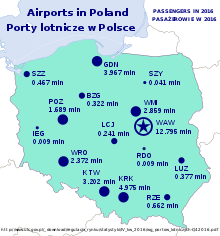
Airports

Rail network
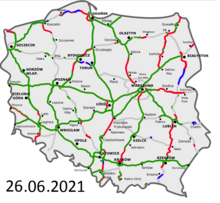
Freeway network

Marie Skłodowska-Curie
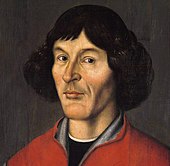
Nicolaus Copernicus

Hiking by the sea eye in the Tatras
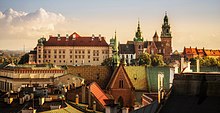
Wawel Cathedral in Krakow
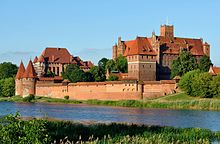
Marienburg in Malbork

Warsaw Stock Exchange

Government debt ratio
.jpg)
Foreign trade development
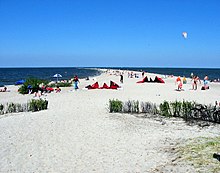
Beach vacation near Putzig
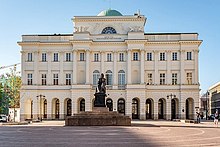
Academy of Science
See also
![]()
Portal: Poland - Overview of Wikipedia content on Poland
Questions and Answers
Q: What is the official name of Poland?
A: The official name of Poland is the Republic of Poland.
Q: What countries border Poland?
A: Poland is bordered by Germany to the east, the Czech Republic and Slovakia to the south, Ukraine and Belarus to the east, Lithuania and Kaliningrad (a Russian exclave) to the north, and has a coastline on the Baltic Sea.
Q: How large is Poland in terms of land area?
A: The total land area of Poland is approximately 312,679 km2 (120,728 mi2), making it slightly larger than Oman.
Q: What are some major cities in Poland?
A: Major cities in Poland include Warsaw (the capital), Łódź, Cracow (Kraków), Szczecin, Gdańsk, Wrocław and Poznań.
Q: When was "Poland" written officially for the first time?
A: "Poland" was written officially for the first time in 966.
Q: When did Poland form a union with Lithuania?
A: In 1569, Poland formed a strong union with Lithuania called the Polish-Lithuanian Commonwealth.
Q: When did communism end in Poland?
A: Communism ended in 1989 when democracy was consolidated and then joined NATO as well as other international organizations such as United Nations and World Trade Organization.
Search within the encyclopedia
